2025.04.21
- Features
-
Services/ProductsServices/ProductsServices/Products

Learn more about the retail trading conditions, platforms, and products available for trading that FXON offers as a currency broker.
You can't start without it.
Trading Platforms Trading Platforms Trading Platforms
Features and functionality comparison of MetaTrader 4/5, and correspondence table of each function by OS
Two account types to choose
Trading Account Types Trading Account Types Trading Account Types
Introducing FXON's Standard and Elite accounts.
close close

-
SupportSupportSupport

Support information for customers, including how to open an account, how to use the trading tools, and a collection of QAs from the help desk.
Recommended for beginner!
Account Opening Account Opening Account Opening
Detailed explanation of everything from how to open a real account to the deposit process.
MetaTrader4/5 User Guide MetaTrader4/5 User Guide MetaTrader4/5 User Guide
The most detailed explanation of how to install and operate MetaTrader anywhere.
FAQ FAQ FAQ
Do you have a question? All the answers are here.
Coming Soon
Glossary Glossary GlossaryGlossary of terms related to trading and investing in general, including FX, virtual currencies and CFDs.
News News News
Company and License Company and License Company and License
Sitemap Sitemap Sitemap
Contact Us Contact Us Contact Us
General, personal information and privacy inquiries.
close close

- Promotion
- Trader's Market
- Partner
-
close close
Learn more about the retail trading conditions, platforms, and products available for trading that FXON offers as a currency broker.
You can't start without it.
Features and functionality comparison of MetaTrader 4/5, and correspondence table of each function by OS
Two account types to choose
Introducing FXON's Standard and Elite accounts.
Support information for customers, including how to open an account, how to use the trading tools, and a collection of QAs from the help desk.
Recommended for beginner!
Detailed explanation of everything from how to open a real account to the deposit process.
The most detailed explanation of how to install and operate MetaTrader anywhere.
Do you have a question? All the answers are here.
Coming Soon
Glossary of terms related to trading and investing in general, including FX, virtual currencies and CFDs.
General, personal information and privacy inquiries.
Useful information for trading and market information is posted here. You can also view trader-to-trader trading performance portfolios.
Find a trading buddy!
Share trading results among traders. Share operational results and trading methods.
- Legal Documents TOP
- Client Agreement
- Risk Disclosure and Warning Notice
- Order and Execution Policy
- Complaints Procedure Policy
- AML/CFT and KYC Policy
- Privacy Policy
- eKYC Usage Policy
- Cookies Policy
- Website Access and Usage Policy
- Introducer Agreement
- Business Partner Agreement
- VPS Service Terms and Condition

This article was :
published
updated
Weekly FX Market Review and Key Points for the Week Ahead
In the foreign exchange market for the week that ended on April 20th, heightened uncertainty over the Trump tariffs continued to make the market nervous. The USDJPY, which plummeted in the previous week, hovered around that week's bottom as it failed to show a clear direction throughout the week. Cautious comments from Federal Reserve Board (FRB) Chairman Jerome Powell, as well as the European Central Bank's (ECB) decision to cut interest rates, also had an impact on the market. However, volumes dropped ahead of the Easter holiday.
April 14 (Mon)
The market reacted sensitively to the Trump tariff news. Although U.S. President Donald Trump announced at the end of the previous week that the U.S. would exempt smartphones and some other electronic devices from reciprocal tariffs, he later reversed course and announced a new tariff policy. As a result, traders took a risk-off stance and bought the yen. Concerns over a possible slowdown in the U.S. economy also triggered a sell-off in the dollar. The USDJPY fell to the 142.2 yen range but later rebounded to the 144.0 yen range.
The EURUSD rose to the 1.14 range during the trading hours. Meanwhile, the GBPUSD rebounded to the 1.32 range as traders bought back the pound.
April 15 (Tue)
The market remained relatively mixed as traders anxiously watched the escalation of the trade war between the U.S. and China. The USDJPY hovered around the 143 yen level. The EURUSD fell to the 1.12 range on a sell-off in the euro. As the pound continued to strengthen against the dollar, the GBPUSD touched the 1.325 range.
April 16 (Wed)
The dollar continued to weaken against the yen after the USDJPY fell below the 143 yen level. Traders reinforced their risk-off stance after FRB Chairman Jerome Powell warned of the impact of tariffs on the economy. As a result, the pair was pushed down to the 141.6 yen range.
The weakening dollar also pushed the EURUSD to the 1.14 range during the trading hours. The GBPUSD rose as high as the 1.329 range. However, after the rally paused, the pair fell back to the 1.323 range.
April 17 (Thu)
Japan's Minister of Economic Revitalization, Ryosei Akazawa, met with U.S. officials on the tariff issue. During the meeting, both parties did not discuss the currency market. Following the news, the USDJPY rose to the 143.0 yen range. However, the rally didn't last long, and the pair was pushed back to the 142 yen range.
Meanwhile, as expected, the ECB cut its policy rate by 25 basis points. The EURUSD hovered around the 1.135 level. The GBPUSD halted its overnight slide and rebounded to the 1.327 range.
April 18 (Fri)
Major markets were closed for Good Friday, with the exception of the Tokyo market, where the dollar weakened slightly against the yen on a thin trading day.
The major currency markets concluded their weekly trading sessions with no significant movement as the USDJPY closed at 142.1 yen, the EURUSD at 1.138, and the GBPUSD at 1.329.
Economic Indicators and Statements to Watch this Week
(All times are in GMT)
April 23 (Wed)
- 14:00 U.S.: March new home sales
This Week's Forecast
The following currency pair charts are analyzed using an overlay of the ±1σ and ±2σ standard deviation Bollinger Bands, with a 20-period moving average.
USDJPY
As long as the outcome of the U.S.-China trade talks remains uncertain, traders are unlikely to rush to abandon their risk-off stance and buy the yen anytime soon. Adding to the uncertainty is the outlook for the U.S. economy. If any economic data points to a slowdown, the dollar is likely to weaken further.
Next is an analysis of the USDJPY daily chart.
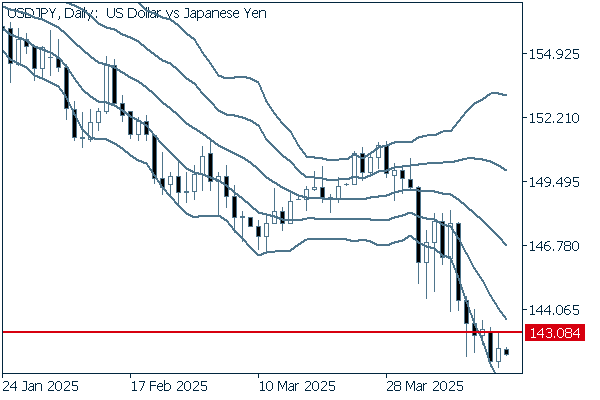

As the downward momentum has weakened, traders are now focusing on whether the pair will be able to rebound above the 143.08 yen level. However, if the downward band walk resumes and the pair continues to fall accordingly, it is highly likely that the pair will break below the 140 yen level. Since it is safe to say that the downtrend is likely to continue, it seems best to follow the trend.
We continue with an analysis of the USDJPY weekly chart.
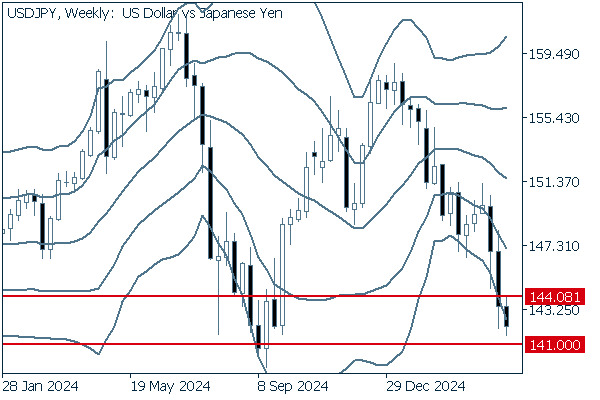

On the weekly chart, the pair has failed to rebound to the middle line as selling pressure remains against the dollar. If the pair fails to break above last week's high of 144.08 yen this week, it is likely to fall to 141.0 yen. It is safe to say that the downtrend is likely to continue.
EURUSD
Although the ECB cut interest rates by 0.25%, the impact on the market was limited as the euro continued to strengthen. On the other hand, the U.S. tariff policy continues to add uncertainty to the market. The dollar's behavior will dominate the market.
Next is an analysis of the EURUSD daily chart.
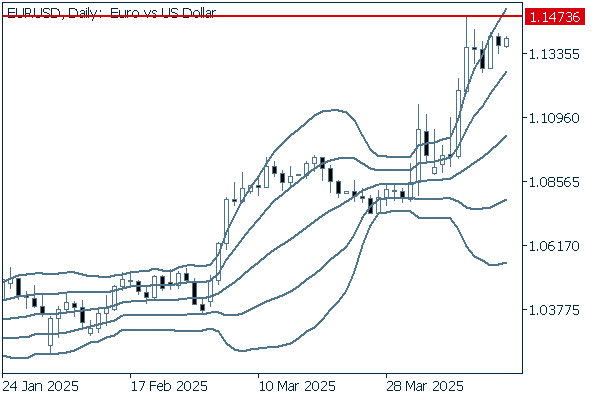

The pair is drawing the upward band walk along the upward +1σ and +2σ as the deviation from the middle line widens. The possible temporary corrective phase may be a good opportunity to buy on the dip. It is safe to say that the uptrend is likely to continue.
We continue with an analysis of the EURUSD weekly chart.
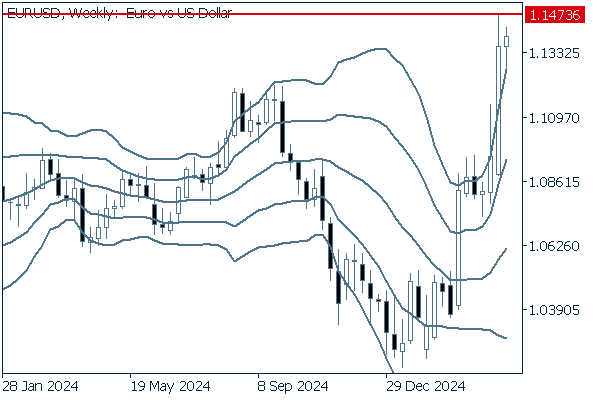

On the weekly chart, five consecutive positive candlesticks have appeared, and the pair has clearly broken above +2σ. If the pair breaks above the current resistance line at 1.1473, the pair is likely to climb higher.
GBPUSD
The weakening dollar is contributing to the steady performance of the GBPUSD. However, it is widely expected that the upcoming U.K.-U.S. tariff talks will put a cap on the pound's aggressive buying momentum. As with the EURUSD, the dollar's behavior will dominate the market.
Now, we analyze the daily GBPUSD chart.
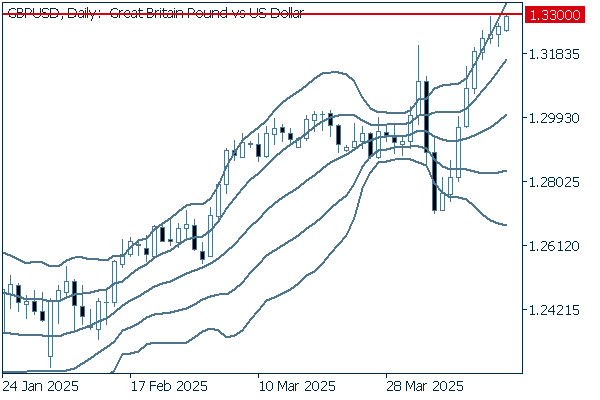

The continuing upward band walk indicates a strong trend in the pound. If the pair breaks above the 1.33 level, there is a possibility that it will continue to rise. A possible temporary corrective phase may be a good opportunity to buy on the dip.
We continue with an analysis of the GBPUSD weekly chart.
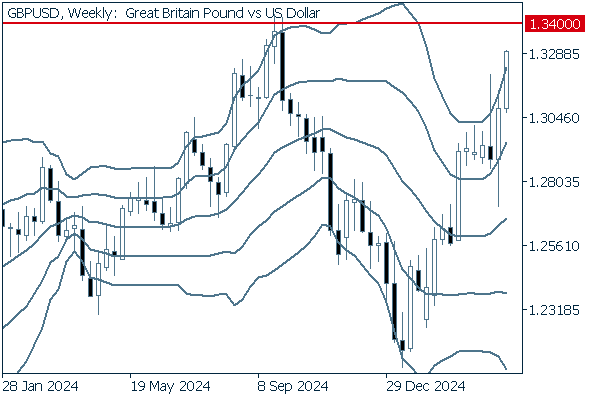

As with the daily chart, the weekly chart also shows a clear trend reversal to the upside. The line drawn at the 1.34 level has just become a fresh resistance line. If the pair breaks above this line, the uptrend is likely to continue.
Was this article helpful?
0 out of 0 people found this article helpful.
Thank you for your feedback.
FXON uses cookies to enhance the functionality of the website and your experience on it. This website may also use cookies from third parties (advertisers, log analyzers, etc.) for the purpose of tracking your activities. Cookie Policy
